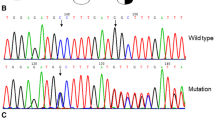Summary
The possible existence of acquired dysfibrinogenemia was investigated in blood samples from 30 patients with liver cirrhosis, 15 newborns and 30 healthy control subjects. Alterations of thrombin time were found in newborns and in 14 cirrhotic patients; glucide fraction levels were measured in these subjects and an increase in sialic acid content was observed. Its functional role was studied by comparing thrombin time and electrophoretic mobility of purified and desialylated forms of fibrinogen. We observed a thrombin time normalization, which was initially prolonged upon the removal of the sialic acid. The anodic electrophoretic mobility underwent changes due to the removal of sialic acid.
Similar content being viewed by others
References
Aminoff D.: Methods for the quantitative estimation ofN-acetylneuraminic acid and their application to hydrolysates of sialomucoids — Biochem. J.81, 384, 1961.
Aznar J., Tascon A., Aznar J. A., Rodriguez-Inerba M.: Técnica rápida para la valoración del fibrinógeno por el método de precipitación por calor — Rev. Diagn. biol. (Madr.)22, 373, 1973.
Barr R. D., Allardyce M., Brunt P. W., McPhie J. L.: Dysfibrinogenemia and liver cell growth — J. clin. Pathol.31, 89, 1978.
Barr R. D., Ouna N., Simpson J. C., Bagshawe A. F.: Dysfibrinogenemia and primary hepatocellular carcinoma — Quart. J. Med.45, 647, 1976.
Bloom A. L.: Intravascular coagulation and liver — Brit. J. Haematol.30, 1, 1975.
Bohn H., Haupt H.: Eine quantitative Bestimmung von Faktor XIII mit Anti-Faktor-XIII-Serum — Thrombos. Diathes. haemorrh. (Stuttg.)19, 309, 1968.
Cessi C., Piliego F.: The determination of amino sugars in the presence of amino acids and glucose — Biochem. J.77, 508, 1960.
Clauss A.: Gerinnungsphysiologische Schnellmethode zur Bestimmung des Fibrinogens — Acta haematol. (Basel)17, 237, 1957.
Grabar P., Williams C. A.: Méthode immunoélectrophorétique d’analyse de mélanges de substances antigèniques — Biochim. biophys. Acta (Amst.)17, 67, 1955.
Gralnick H., Givelber H., Abrams E.: Dysfibrinogenemia associated with hepatoma: increased carbohydrate content of fibrinogen molecule — New Engl. J. Med.299, 221, 1978.
Jim R. T. S.: A study of the plasma thrombin — J. Lab. clin. Med.50, 45, 1957.
Kwan S. W., Fuller G. H.: Immunochemical characterization of fibrinogen induction in rat liver — Biochim. biophys. Acta (Amst.)475, 659, 1977.
Lane D. A., Scully M. F., Thomas D. P., Kakkar V. V., Woolf I. L., Williams R.: Acquired dysfibrinogenaemia in acute and chronic liver disease — Brit. J. Haematol.35, 301, 1977.
Laurell C.-B.: Electroimmunoassay — Scand. J. clin. Lab. Invest.29 (Suppl. 21), 124, 1972.
Martinez J., Palascak J., Kwasniak D.: Abnormal sialic acid content of the dysfibrinogenemia associated with liver disease — J. clin. Invest.61, 535, 1978.
Merskey C., Lalezari P., Johnson A. J.: A rapid, simple, sensitive method for measuring fibrinolytic split products in human serum — Proc. Soc. exp. Biol. (N.Y.)131, 871, 1969.
Mester L., Szabados L.: Structure défectueuse et biosynthèse des fractions glucidiques dans les variantes pathologiques du fibrinogène — Nouv. Rev. franç. Hématol.10, 679, 1970.
Narvaiza M. J.: Contribución al estudio de las alteraciones funcionales y físicoquímicas del fibrinógeno en la cirrosis hepática. Tesis doctoral, Universidad de Navarra, 1979.
Palascak J., Martinez J.: Dysfibrinogenemia associated with liver disease — J. clin. Invest.60, 89, 1977.
Ratnoff O. D., Menzie C.: A new method for the determination of fibrinogen in small samples of plasma — J. Lab. clin. Med.37, 316, 1951.
Roberts H. R., Cederbaum A. I.: The liver and blood coagulation: physiology and pathology — Gastroenterology63, 297, 1972.
Soria J., Soria C., Durand G., Feger J.: Electrofocalisation de fibrinogènes anormaux en gel de polyacrylamide — Ann. Biol. clin.30, 161, 1972.
Straub P. W., Funk C.: The Reptilase time in presence of fibrinogen degradation products — Scand. J. Haematol.13 (Suppl.), 257, 1971.
Author information
Authors and Affiliations
Rights and permissions
About this article
Cite this article
Narvaiza, M.J., Fernández, J., Cuesta, B. et al. Role of sialic acid in acquired dysfibrinogenemia associated with liver cirrhosis. La Ricerca Clin. Lab. 16, 563–568 (1986). https://doi.org/10.1007/BF02886840
Accepted:
Issue Date:
DOI: https://doi.org/10.1007/BF02886840




